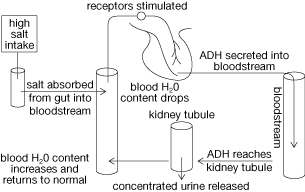Module 8 Intro
1. Module 8 Intro
1.50. Page 2
Module 8—Circulation, Immunity, and Excretion
 Explore
Explore
 Read
Read
The body’s water or osmotic balance is critical to the maintenance of blood plasma solute concentration and blood volume. Both of these factors play roles in the movement of materials between the cells and the blood as well as blood pressure. When the balance between blood volume and blood plasma solute concentration are disrupted, the body’s systems may begin to fail, with possible disastrous consequences.
Water intoxication is an interesting example of how your body can react to imbalance. Water intoxication occurs when the normal balance of electrolytes in the body become severely altered due to an excess of water consumption. This can impair brain function much like alcohol, but for different reasons.
The concentration gradient between ions such as sodium and outside cells is lowered. Osmotic pressure is reversed and water moves into the cells in an effort to balance concentration. Electrolyte imbalance and tissue swelling can cause fluid in the lungs and an irregular heartbeat. Swelling puts pressure on the brain and nerves, which can produce behaviour resembling alcohol intoxication. Water intake must be restricted and an electrolyte solution given to someone suffering from water intoxication before swelling causes too much damage.
dehydration: a relative deficiency of water molecules in relation to other dissolved solutes; can be caused by blood loss, vomiting, excess exertion, or malnutrition
hypothalamus: a gland located above the brain stem and connects the nervous system with the endocrine system by relaying messages to the pituitary gland; it is the size of an almond
osmoreceptors: a sensor found in the hypothalamus of the brain that detects changes in osmotic pressure
antidiuretic hormone: a hormone in all mammals that stimulates increased water reabsorption by the kidneys; also called vasopressin
Instances of water intoxication are much less common than the opposite extreme of dehydration. Your body has a mechanism to respond to high osmotic pressure in your bloodstream that occurs under dehydrated conditions. High osmotic pressure occurs when there is low water and high solute (salt) concentrations.
Osmotic pressure is controlled by the hypothalamus and its interaction with the posterior pituitary gland of the brain. The hypothalamus contains osmoreceptors. Osmoreceptors detect osmotic pressure. If osmotic pressure is high, the pituitary is stimulated to release a hormone called antidiuretic hormone, or ADH. ADH increases the permeability of the distal tubule and collecting duct of the nephron to water. ADH is sometimes referred to as vasopressin due to its secondary effect of causing a moderate increase in blood pressure through vasoconstriction. By increasing the permeability of these regions of the nephron, water is reabsorbed back into the bloodstream. This lowers the osmotic pressure—a negative feedback effect.
A simple feedback loop showing this interaction can be illustrated as follows.

diabetes insipidus: a condition characterized by the excretion of large amounts of severely diluted urine, which cannot be reduced when fluid intake is reduced
It denotes an inability of the kidney to concentrate urine. DI is caused by a deficiency of antidiuretic hormone (ADH), also known as vasopressin.
A number of circumstances can decrease ADH release from the pituitary. Individuals with diabetes insipidus are unable to produce sufficient quantities of ADH to allow for normal water reabsorption. These people release large quantities of dilute urine, leading to dehydration. The consumption of alcoholic beverages, as well as caffeinated drinks, temporarily blocks the release of ADH. This also leads to increased urine output and subsequent dehydration.
 Self-Check
Self-Check
SC 1. What is the role of osmoreceptors in regulating water reabsorption?
SC 2. What is the role of ADH in maintaining the volume of water in the body?
 Self-Check Answers
Self-Check Answers
SC 1. Osmoreceptors are sensitive to osmotic pressure and will stimulate or inhibit the release of ADH from the pituitary.
SC 2. ADH increases the permeability of the distal tubule and the collecting duct to allow more water to be reabsorbed into the blood. ADH is secreted under conditions of dehydration so that your body conserves water.
 Read
Read
The Reabsorption of Salts
aldosterone: a hormone that causes the tubules of the kidneys to retain sodium and water
This increases the volume of fluid in the body, and drives up the blood pressure.
The kidneys reabsorb Na+ or sodium ions at the proximal tubule of the nephron. A further reabsorption of Na+ also occurs at the distal tubule and collecting duct when Na+ levels in the bloodstream drop abnormally. This secondary Na+ reabsorption may also be related to a drop in blood pressure and is under the control of the hormone aldosterone.
What happens when blood pressure drops or Na+ concentration in the blood is reduced? Receptors found in the kidney release an enzyme called renin. Renin converts another enzyme, angiotensinogen, to its active form of angiotensin. Angiotensin causes a constriction of blood vessels and increases the thirst sensation. At the same time, it stimulates the release of aldosterone from a triangular-shaped gland located on top of each kidney.
Aldosterone stimulates the distal tubules and collecting ducts to reabsorb Na+. Negatively charged chlorine ions and water are also reabsorbed, which has the net effect of retaining salt and water. Aldosterone also stimulates the secretion of K+ into the distal tubes and collecting ducts if the concentration of potassium ions in the blood is high.
 Try This
Try This
TR 1. Maintaining Homeostasis
You will be given a variety of situations and you will conduct research and create a flow chart to describe how humans maintain homeostasis with respect to water and ions.
Go to your Lesson 9 Assignment for further instructions.